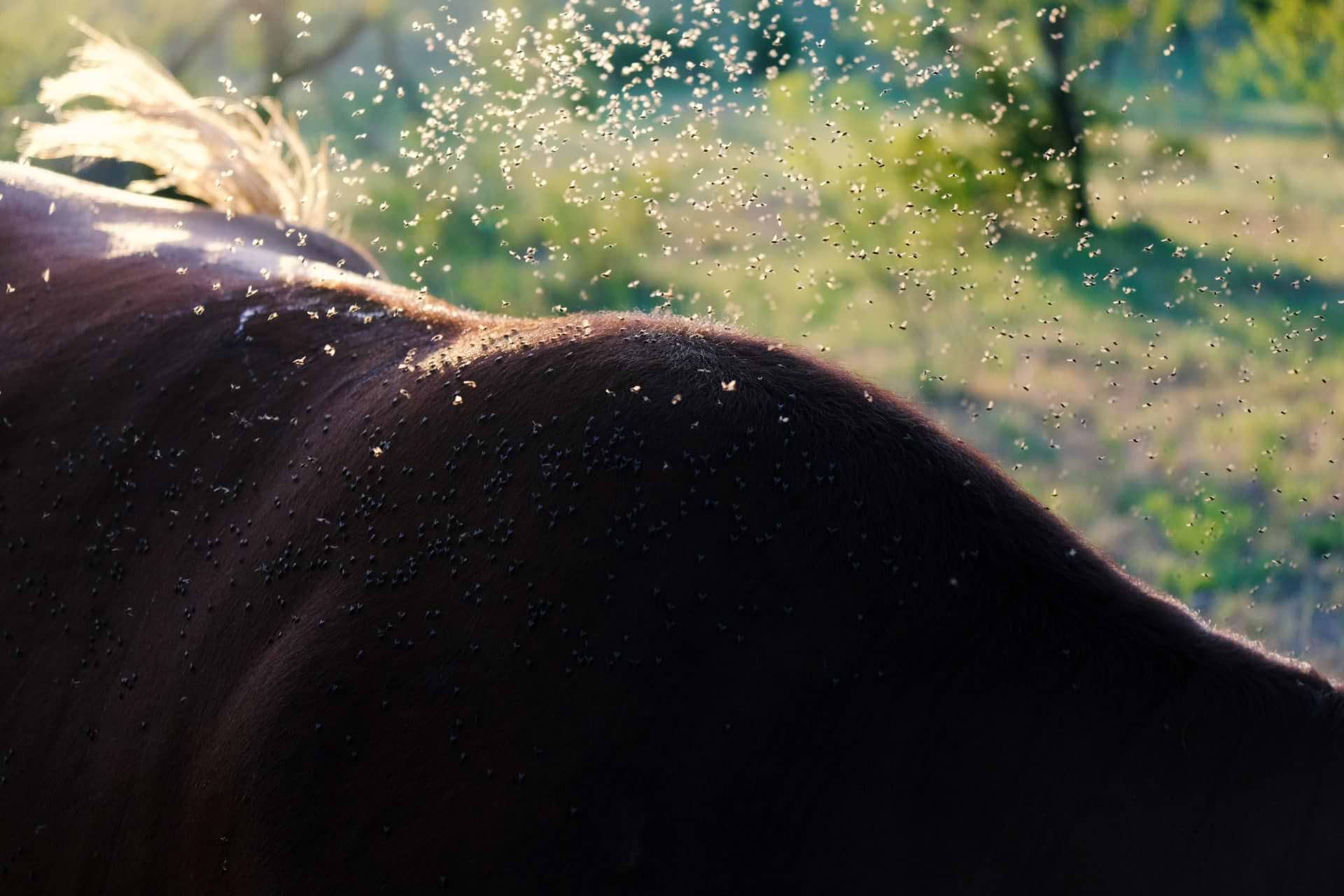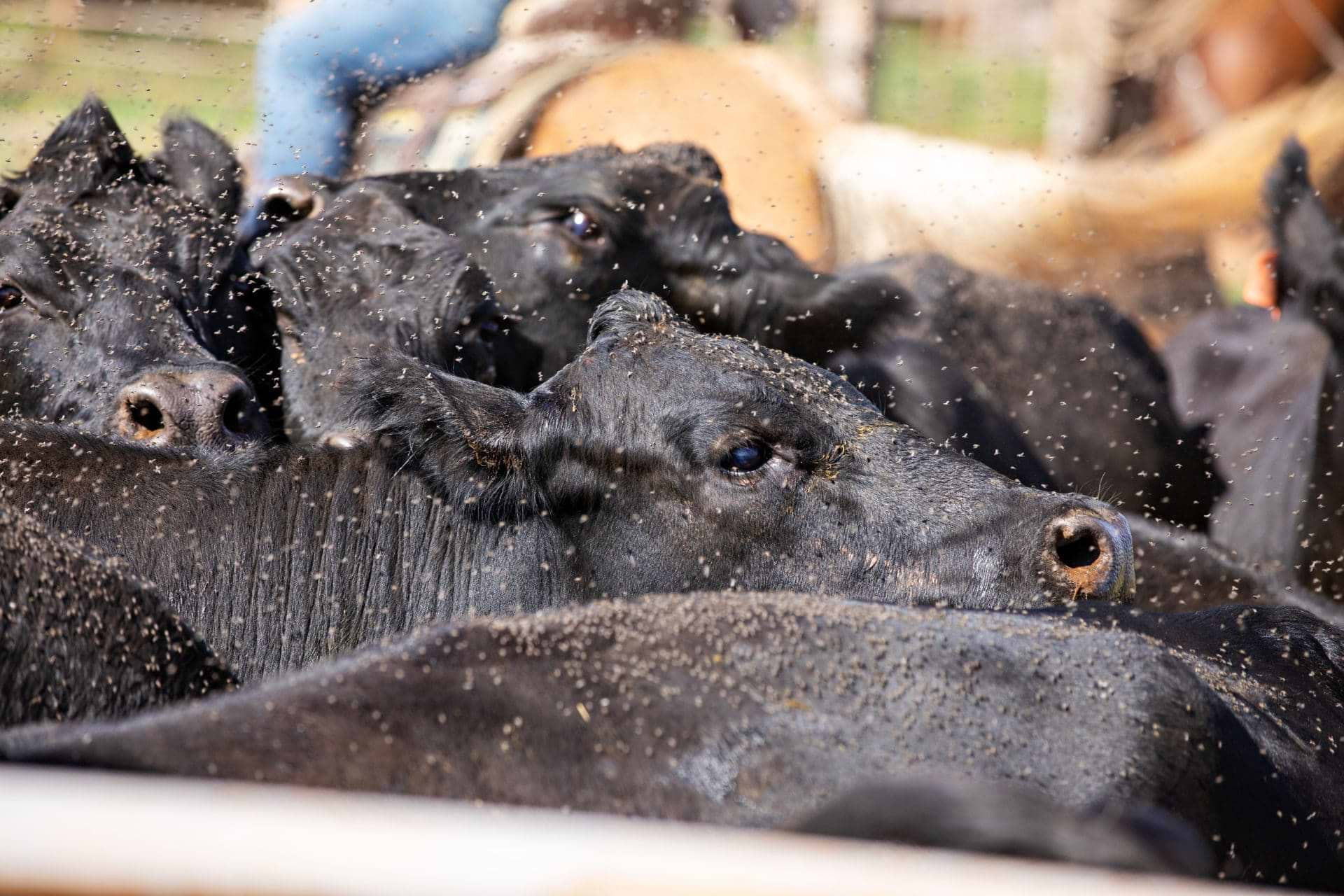Last updated on May 1st, 2025 at 01:52 pm
Just about everything that lives in cattle country looks forward to warmer spring weather. That’s perhaps especially true for cattle producers. And the flies that torment cattle and cattle producers alike.
There are three main species of flies that are pests for cattle—
- Horn flies
- Face flies
- Stable flies.
Let's take a look at each; how they affect cattle and how you can get them under control on your own operation.
Horn Fly
The horn fly is one of the most important blood-feeding pests that pasture cattle contend with. It’s estimated the annual economic loss is greater than $1 billion from this pest alone.

That loss comes from decreased milk production, reduced weight gain, changes in grazing patterns and bunching brought on by irritation from biting flies. Research studies have found that weaning weights are negatively impacted from 4% to 15% and stocker cattle and replacement heifers experience up to 18% impact in weight gain, according to Dave Boxler, Extension educator with the University of Nebraska-Lincoln.
Horn flies are found on the shoulders, back and belly of cattle and take from 24 to 38 blood meals a day. Female horn flies lay eggs in fresh manure where the life cycle is completed in 10 to 20 days. That means there are multiple generations of horn flies during fly season, and concentrations can build throughout the summer.
Horn Fly Control Economics
The economic threshold where control becomes cost effective is 200 flies per animal. It doesn’t take long for that level to happen, so control should begin early. Check with your veterinarian or Extension professional for specific recommendations for your area.
There are many different control methods for horn flies, some of which are more labor-intensive than others. For cattle on summer pasture, where handling the animals every two to three weeks isn’t feasible, IGRs and ear tags are probably the most effective ways to control horn flies. Other fly control methods include oilers, dust bags, pour-ons, low pressure sprayers and misters.
IGR Fly Control
IGRs or insect growth regulators are oral larvicides the cattle consume in feed or mineral supplements. They decrease horn fly populations by disrupting growth of the fly larvae in the manure, preventing them from becoming adults.
Cattle Ear Tag Fly Control
Insecticide-infused ear tags are a common and convenient tool for fly control in pasture cattle but it’s important not to apply them too early. That’s because, if applied too early in the season, they may lose effectiveness later on during the fly season when fly numbers tend to be highest. And be sure to pull the tags at the end of the season to reduce the amount of insecticide resistance in the fly population.
It’s best to apply two tags to the cow and to rotate the insecticide every couple of years to prevent resistance buildup in the flies. It’s not necessary to tag calves since horn flies usually leave them alone.
Face Fly
Face flies are nonbiting pests that feed on animal secretions. Adult flies usually cluster around the eyes, mouth and muzzle, causing significant irritation. They also congregate around wounds to feed on blood and other secretions.
In addition to being an irritant, face flies spread the disease agent that causes pinkeye. If coupled with the IBR virus, a much more serious condition may result. Females lay eggs in fresh manure and the complete lifecycle takes around 28 days, according to Adele Harty, Extension cow-calf field specialist at South Dakota State University.

Face flies spend most of their time hanging out in the shade, resting on plants, fence posts and other places. Because face flies stay on animals for only a short time, they’re difficult to control. Effective control may require more than one method of treatment, Harty says, including ear tags, dust bags and sprays. In contrast to horn flies, both cows and calves must be treated.
Stable Fly
Stable flies congregate around the legs where they take their blood meals. That’s why cattle will stomp and switch their tails, stand in water, lay with their feet under them or bunch up in corners, Boxler says.
The economic threshold of five flies per leg is easily exceeded and results in significant irritation to cattle. Research in Nebraska found average daily gain was reduced by 0.44 pound per head per day with animals that didn’t receive insecticide compared with those that did.
Stable flies can travel up to 10 miles and develop in rotting organic matter mixed with manure and dirt. If that sounds like the area around hay rings or other feeding spots, you’re right. Fly populations can be controlled by spreading the hay-manure-dirt piles so the material can dry.
Because stable flies feed on the lower legs of cattle, the only option to kill stable flies is sprays. For pasture cattle, that’s not really an option. But that doesn’t mean, beyond cleaning up fly breeding areas, that another option isn’t available, says Ashley Kettner, former beef specialist with Rio Nutrition.
Cattle Fly Control Options
Riomax® offers three different fly control tub formulas: one with IGR, one with a blend of natural repellents such as garlic, and one with both!
Garlic for Fly Control
Among the things garlic is known for is it strong, pungent smell. When garlic bulbs are sliced or crushed, they release sulfurous compounds. This strong odor is designed to repel attacking pests.
When cattle ingest these strong-smelling compounds, the unappealing odor comes out through their sweat glands and manure and naturally repels flies that don’t like the smell. What’s more, garlic works to repel many of the pests that torment cattle. Garlic’s natural odor repels anything from stable flies, face flies and horn flies to mosquitoes, fleas and even ticks, Kettner says.
And because garlic is an all-natural product, it works for beef producers in an organic or similar value-added program. When added to the Riomax® tub formula, it repels flies while giving cattle all the other benefits that Riomax® provides.
RELATED: Riomax® PG360-REPEL™ Natural Fly Control Mineral Tubs
IGR (Insect Growth Regulator) Fly Control
This fan favorite fly control tub is formulated with both Altosid IGR and natural anti-parasitic ingredients for a double-barreled attack on flies. As cattle consume the mineral supplement, the insect growth regulator passes through the animal and into the manure. There, as fly larvae are feeding, they consume the IGR which disrupts their growth and breaks the life cycle of horn flies. Meanwhile, the natural anti-parasitic and antioxidant components are repelling insects from the outside.

Grassfed-Approved All Natural Fly Control
Our third fly control tub is formulated specifically for grassfed only operations. It provides all-natural heavy duty fly control that repels face flies & other insects. Currently, this is only available in the USA.
RELATED: Riomax® PROGRASS360-REPEL Fly Control Mineral Tubs
It’s important to note that you never will get rid of all your flies. But you can keep them at manageable levels, something both your cattle and you will appreciate.


